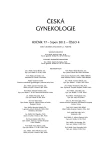Vaginal prolapse and levator ani avulsion injury
Authors:
K. Švabík; M. Martan; J. Mašata
Authors place of work:
Gynekologicko-porodnická klinika, 1. LF UK a VFN, Praha
Published in the journal:
Ceska Gynekol 2012; 77(4): 304-307
Summary
Levator ani avulsion injury is one of the main factors associated with vaginal prolapse of all compartments. Levator avulsion is the main link between vaginal delivery and subsequent vaginal prolapse – cause and sequel.
The risk for prolapse is doubled in women with levator injury (RR = 1,9).
The risk for prolapse is mainly expressed for anterior and central compartment.
In retrospective analysis of women after vaginal repair without use of implants the recurrence rate was 29%. In subanalysis of only of women with recurrence the avulsion injury was detected in 85%. The risk of recurrence of prolapse after native tissue repair is four times higher if the avulsion is present to those where not.
Levator avulsion injury is main etiological and risk factor associated with uterine and vaginal prolapse as the sequel of delivery trauma. This injury also increases significantly the risk of prolapse recurrence after native tissue vaginal repair.
Key words:
avulsion injury, levator ani, vaginal prolapse, 4D ultrasound.
Zdroje
1. DeLancey, JO. Anatomy and biomechanics of genital prolapse. Clin Obstet Gynecol, 1993, 36, p. 897–909.
2. DeLancey, JO., Morgan, DM., Fenner, DE., et al. Comparison of levator ani muscle defects and function in women with and without pelvic organ prolapse. Obstet Gynecol, 2007, 109, p. 295–302.
3. Dietz, HP. The aetiology of prolapse. Int Urogynecol J Pelvic Floor Dysfunct, 2008, 19, p. 1323–1329.
4. Dietz, HP., Franco, V, Shek, KL., Kirby, A. Avulsion injury and levator hiatal ballooning: two independent risk factors for prolapse? An observational study. Acta Obstet Gynecol Scand, 2012, 91, p. 211–214.
5. Dietz, HP., Chantarasorn, V, Shek, KL. Levator avulsion is a risk factor for cystocele recurrence. Ultrasound Obstet Gynecol, 2010, 36, p. 76–80.
6. Dietz, HP., Kirby, A. Modelling the likelihood of levator avulsion in a urogynaecological population. Aust N Z J Obstet Gynaecol, 2010, 50, p. 268–272.
7. Dietz, HP., Shek, KL. Tomographic ultrasound imaging of the pelvic floor: which levels matter most? Ultrasound Obstet Gynecol, 2009, 33, p. 698–703.
8. Dietz, HP., Simpson, JM. Levator trauma is associated with pelvic organ prolapse. BJOG. 2008, 115, p. 979–984.
9. Fialkow, MF., Newton, KM., Lentz, GM., Weiss, NS. Lifetime risk of surgical management for pelvic organ prolapse or urinary incontinence. Int Urogynecol J Pelvic Floor Dysfunct, 2008, 19, p. 437–440.
10. Fialkow, MF., Newton, KM., Weiss, NS. Incidence of recurrent pelvic organ prolapse 10 years following primary surgical management: a retrospective cohort study. Int Urogynecol J Pelvic Floor Dysfunct, 2008, 19, p. 1483–1487.
11. Gainey, HL. Post-partum observation of pelvic tissue damage. Am J Obstet Gynecol, 1943, 46, p. 457–466.
12. Green, TH. Jr. Urinary stress incontinence: differential diagnosis, pathophysiology, and management. Am J Obstet Gynecol, 1975, 122, p. 368–400.
13. Halban, J., Tandler, J. Anatomie und Aaetiologie der Genitalprolapse beim Weibe. 1907, Vienna: Wilhelm Braumuller.
14. Hoyte, L., Schierlitz, L., Zou, K., et al. Two- and 3-dimensional MRI comparison of levator ani structure, volume, and integrity in women with stress incontinence and prolapse. Am J Obstet Gynecol, 2001, 185, p. 11–19.
15. Krofta, L., Otcenasek, M, Kasikova, E., Feyereisl, J. Pubococcygeus-puborectalis trauma after forceps delivery: evaluation of the levator ani muscle with 3D/4D ultrasound. Int Urogynecol J Pelvic Floor Dysfunct, 2009, 20, p. 1175–1181.
16. Maher, CM., Feiner, B., Baessler, K., Glazener, CM. Surgical management of pelvic organ prolapse in women: the updated summary version Cochrane review. Int Urogynecol J, 2011, 22, p. 1445–1457.
17. Model, AN., Shek, KL., Dietz, HP. Levator defects are associated with prolapse after pelvic floor surgery. Eur J Obstet Gynecol Reprod Biol, 2010, 153, p. 220–223.
18. Olsen, AL., Smith, VJ., Bergstrom, JO., et al. Epidemiology of surgically managed pelvic organ prolapse and urinary incontinence. Obstet Gynecol, 1997, 89, p. 501–506.
19. Patel, DA., Xu, X., Thomason, AD., et al. Childbirth and pelvic floor dysfunction: an epidemiologic approach to the assessment of prevention opportunities at delivery. Am J Obstet Gynecol, 2006, 195, p. 23–28.
20. Shek, KL., Dietz, HP. The effect of childbirth on hiatal dimensions. Obstet Gynecol, 2009, 113, p. 1272–1278.
21. Shek, KL., Pirpiris, A., Dietz, HP. Does levator avulsion increase urethral mobility? Eur J Obstet Gynecol Reprod Biol, 2010, 153, p. 215–219.
22. Steensma, AB., Konstantinovic, ML., Burger, CW., et al. Prevalence of major levator abnormalities in symptomatic patients with an underactive pelvic floor contraction. Int Urogynecol J, 2010, 21, p. 861–867.
23. Svabik, K., Shek, KL., Dietz, HP. How much does the levator hiatus have to stretch during childbirth? BJOG, 2009, 116, p. 1657–1662.
24. Weemhoff, M., Vergeldt, TF., Notten, K., et al. Avulsion of puborectalis muscle and other risk factors for cystocele recurrence: a 2-year follow-up study. Int Urogynecol J, 2012, 23, p. 65–71.
25. Wong, V., Shek, KLG., Rane, A., Dietz, HP. Should mesh be used for cystocele repair? Long-term outcomes of a case-control series. Int Urogynecol J Pelvic Floor Dysfunct, 2011, 22 (Suppl. 1), p. S91.
26. Zhuang, RR., Song, YF., Chen, ZQ., et al. Levator avulsion using a tomographic ultrasound and magnetic resonance-based model. Am J Obstet Gynecol, 2011.
Štítky
Dětská gynekologie Gynekologie a porodnictví Reprodukční medicínaČlánek vyšel v časopise
Česká gynekologie

2012 Číslo 4
Nejčtenější v tomto čísle
- Endometrióza
- Prolaps a avulzní poranění levatoru
- Gynekologicko-porodnická klinika „U Apolináře“
- Racionální předoperační diagnostika benigních a maligních ovariálních nádorů – zobrazovací metody, nádorové markery
